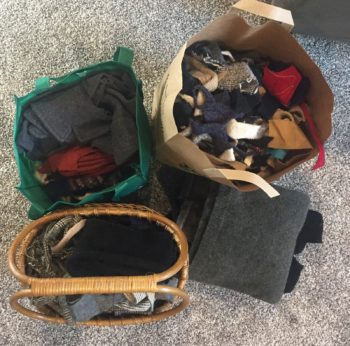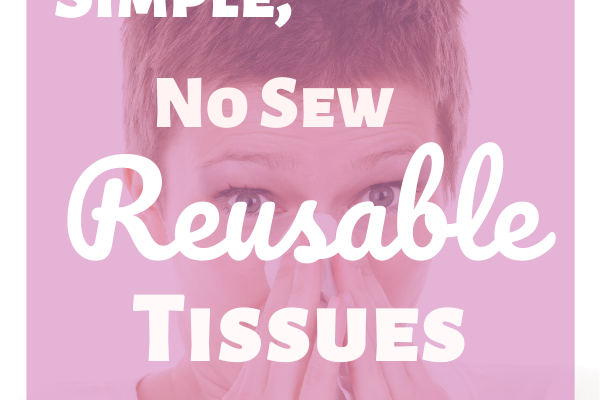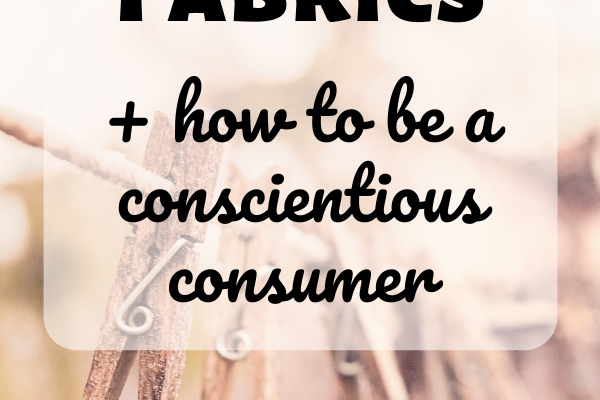Every crafter has a favorite medium; my favorite medium is wool — braided rugs, baby booties, purses, pillows. I’ll gladly spend hours surrounded by the knits and weaves.
The other day I was cleaning through some of my stash and soft, scratchy,  scraps, and strips were my piles. I never throw out wool. Not even the tiniest
scraps, and strips were my piles. I never throw out wool. Not even the tiniest
scrap. It’s all saved for future projects or to be used as stuffing (pillows, dog beds, stuffed animals). The piles got me thinking about how so many people that I speak with think that all wool is created equally, but it’s not true, so if you have a minute, allow me to give you a brief overview of what I’ve learned in my experience:
The Soft Wools
Soft wools are wonderful! Finding a soft wool item second hand for cheap will make my day. I can’t help but immediately crumple a soft wool sweater into a ball and rub it across my face when I find one (not in a weird way, though). Soft wools are typically derived from less standard sources such as camel, cashmere (goat), and alpaca. There is some sheep wool that is soft though, such as lambswool and merino, but most fall into the scratchy category. Soft wools are great for projects for babies and young children.
The Scratchy Wools
Generally speaking, your scratchy wools come from full grown sheep. You’ll likely find a larger variety of colors and patterns in scratchy wools at second-hand stores, although on occasion you will come across a coat or sweater broadly labeled “wool” that’s soft.
I use scratchy wools for a whole other list of crafts: purses (lined with another fabric), decorative pillows, or as a base for needle felting. Woven varieties are also great for these projects, as well as for braided wool rugs. When I say woven, I’m talking about the article’s construction.
Construction
Texture is only part of the variation in upcycled wool; the other thing that will vary from project to project is how the fabric was constructed. In the upcycled world, you’re generally looking at knits and weaves.
Knits
Yeah, knits! Sweaters are the most commonly found knit items. These products have a fair amount of stretch and can easily be felted (shrunken) to make other items. Felting is the process by which you create a greater bond between the wool threads by agitating them.
Wool threads have tiny barbs on them that, when agitated, stick together. Generally, agitation for blankets and articles of clothing is best done in the washing machine with hot water and soap. Felting needles (like the one below) can also be used for felting in projects using roving wool. Felting needles also have barbs, which push and pull the wool threads together, creating a tighter bond with each puncture. Scary little things, aren’t they?

Why felt your wool? A wool knit will no longer unravel after it’s been felted. Felting also reduces how much a project will shrink going forward. I like to wash my felted items twice to limit future shrinking, but still recommend that projects be air dried after creation.
I use felted knits (shrunken, upcycled sweaters) to make or line baby booties; many people make mittens with them for the cold midwestern winters, frequently lining them with (non-wool) fleece for extra warmth and to keep the interior soft.
Weaves
Woven wool is what started my love of this medium through a class in rug braiding. Pants, coats, suits, skirts. The colors and patterns lend themselves perfectly to all kinds of upcycled projects. When I first started wooling, I found a gem of a second hand store with an abundance of winter coats and suit coats at reasonable prices; they also had frequent 50% off sales. I built a stash that I eventually needed to rein in before it took over our basement.

Woven wool is less elastic than knits and while it will shrink up a bit if washed and dried, it won’t shrink up nearly as much as knits, although this is largely determined by the density of the weave (ditto with knits, I suppose). Woven wool is what is used for braided wool rugs — a process I’ll cover later.
A quick note related to woven wool: blankets. If you can find a wool blanket for cheap, you’ve hit the jackpot! They require no disassembly so are project-ready after running through the washing machine. They’re also great for dogs (or cats) to sleep on, as they’re super warm. Or, if you’re like my husband, you like to keep one in the back your car because your wool-loving wife has made you discriminate as to the material you cart your crap around on.
So that’s my general knowledge on the very broad topic of wool. There’s lots you can know about wool, but in my experience, all you really need to know, you can learn through love.
There is one more kind of wool that I didn’t cover here — roving wool. If you’re interested in spinning or needle felting, you’ll need to invest in some roving wool. I’ve dabbled in needle felting, but have never tried spinning (nor have I had the desire to do so), but if you’re interested, I highly encourage you to explore these ventures further!
Are you crafty? What’s your favorite medium? I’d love to hear about your love of it below!
— Funky Crunchy Mama







Hi!
I love that you delved into the different kinds of wool and their beginnings! Never knew some of that before 🙂 I’m a winter knitter/crocheter and enjoy working with soft, warm textures. Now I know what to look for! Thank you.
I never knew wool was so complicated! Not just warm fuzzy sweaters, LOL. I have a habit of shopping 2nd hand stores and I just walk down the racks and run my hands over the rows of hanging clothing until I ‘feel’ something that I like the texture of. Have found uber good deals on cashmere, alpaca and even silk this way. Informative article. 🙂
Oh my goodness I love wool too! I was recently given a drop spindle, so my next endeavour is to learn to spin.
I love meeting fellow wool lovers! Good luck with drop spinning! I’ve always been intrigued.
I have been thinking about making a rug and I crochet quite a bit. This article is a wonderful reference to look back on!
I’d love to see your results and to hear how you like it if you go for making the rug. 🙂 I think making them is so addictive!
Lover of wool right here! I just spent the last 7 years raising sheep (Icelandic Sheep) so fell in love with all the steps involved with sheep to shawl. Currently on a break from farming while we explore the S Pacific (and just the thought of wool makes me sweat), but I miss it for sure. Enjoy for me!
That sounds so lovely — all of it! I’ll certainly enjoy the wool on your behalf this winter. 🙂 Enjoy some warm weather for me!